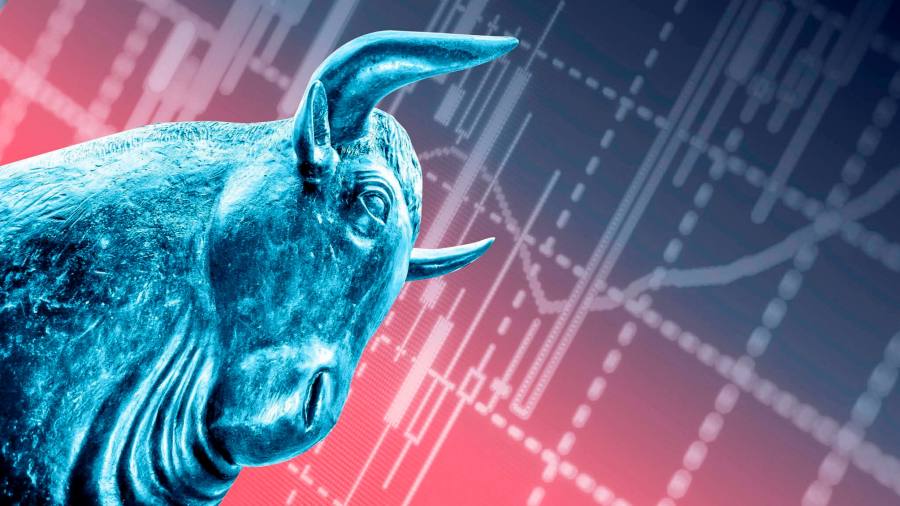Good morning. Unhedged is eager to read this Friday’s personal consumption expenditures report, the last bit of inflation data Federal Reserve officials will see before their meeting next week. Fed smoke signals suggest an interest rate pause is coming soon — but how soon? Until then, let us know what’s catching your eye: [email protected] and [email protected].
More on the global stock rally
As we wrote last week, US equities have been getting trounced by the rest of the world, as Chinese, European and emerging market stocks take off:
We noted three basic reasons this is happening: a weakening dollar, cheaper energy and investors becoming keen on value stocks. Today, more thoughts on each.
Start with the dollar, which has come down 10 per cent from its peak in September, as measured by the DXY dollar index. By pure maths, a weaker USD has the effect of boosting many popular ROW stock indices, which are often denominated in dollars. But it carries implications for fundamentals, too.
An important reason the dollar index has fallen is the striking resurgence of the euro, which makes up 58 per cent of the DXY basket. Renewed confidence in Europe’s economy is having an effect. Cheaper energy has helped the continent (see below), as has the potential reopening of China, Europe’s largest trade partner in goods. But a less appreciated fact until recently is the sheer heft of Europe’s recent fiscal intervention.
One estimate last year, from Allianz, put total EU fiscal support near 3 per cent of GDP, much of which followed the Ukraine energy price surge. The knock-on effects have surprised many. Nanette Abuhoff Jacobson, a strategist at Wellington Management, told Unhedged Europe’s fiscal support is a major reason she is currently reconsidering her “underweight” view on European equities.
Emerging markets benefit more directly from a weakening dollar. Many are either import dependent (where a strong dollar drives up costs) or carry large dollar-denominated debt loads, or both. So it is unsurprising they would start overperforming as the dollar falls, but this time round EMs have the added appeal of having managed through the strong-dollar phase remarkably well. This chart from Oxford Economics shows how sturdy EM real activity (red line) has been compared to past periods of dollar strength (blue line; down means stronger dollar) like 2015:
As Wei Li of the BlackRock Investment Institute argues, EM central banks and policymakers have learned from past strong-dollar tightening cycles:
EM external balances have improved, central banks were ahead of DM in policy tightening, and higher commodity prices limited the fallout. Yet EM equities have underperformed DM peers — down nearly 20 per cent since mid-2021, when many EM central banks began to tighten policy. This slump might be warranted if there were some systemic risk for EM looming — but we don’t see that now. We think the long EM stock slide and recent rally show a lot of economic damage is now in the price as the EM backdrop turns more supportive . . .
We think the backdrop will turn more positive for EM, building on recent resilience. EM generally has higher levels of currency reserves, smaller current account deficits, improved external balances and better debt maturity mixes than they did in past DM tightening cycles that sparked volatility.
Where the dollar goes next hinges on the US economy. The dollar tends to strengthen during periods of US economic outperformance as well as when co-ordinated global slumps push investors into safer US assets — the two upturned sides of the “dollar smile”. When US performance is simply average, however, the dollar sinks. Rising expectations that Europe will avoid recession probably mean a US soft landing would make for a weaker dollar, while a US recession damaging global demand would be dollar-positive. You could see hints of that last Wednesday, when bad US economic data pushed stocks and yields down, but the dollar up.
Which prompts the question: could ROW outperformance, which is relatively recent, persist through a dollar-strengthening US recession?
Falling energy prices support global share outperformance in a number of ways. High energy prices slow growth and sop up liquidity everywhere, but because the US is the largest oil producer in the world, it enjoys a natural hedge. Furthermore, stocks in Europe and Japan lean heavily to energy-intensive industries. Oil prices are well off their peaks, and have been stable around $80 since September. But our colleagues at FT Energy Source have recently noted that many observers expect a leg up in prices, for two reasons. One is China:
Oil consumption is set to rise sharply after Beijing abruptly lifted its zero-Covid policy last month, analysts argue. More driving and flying will fuel an energy demand recovery similar to when pandemic restrictions were eased across the US and Europe. China’s re-emergence from lockdowns will be enough to propel global crude demand above last year’s pace even as consumption growth across the US and Europe sputters, many analysts say
The other is Russia:
Fresh sanctions on imports of Russian oil products such as petrol and diesel into Europe will come into force in early February. That will add to existing bans on crude imports, restrictions on European companies’ ability to insure oil shipments, and the price cap western governments have tried to impose on Russian crude . . . analysts say the sanctions are starting to take a toll on production.
The anticipation of the demand/supply double whammy explains why the share of many energy companies have been relatively stable even as oil prices have fallen.
The final aspect of the global stocks rally is better performance of value stocks, relative to growth stocks, especially the mega-cap tech stocks which long led US markets higher. Global stocks are cheaper than the US on almost every measure, and investors seem to like cheap stuff lately. This chart from last week, comparing the relative performance of US value and growth stocks and the relative performance of US and global stocks, is very striking:
That said it is not clear that the rally in global stocks is a value rally, exactly. Looking at European performance is instructive in this respect. Here is the performance of European sectors since the global rally began in late October:
European financials, which had been trading dirt cheap, have had a nice rally. Big banks like HSBC and Bank Paribas, and big insurers like Prudential Plc and AXA, have notched huge gains. But the best-performing sector is consumer discretionary, where valuations (outside of car companies) tend to be higher. And looking at the companies that have seen the biggest increases in market cap (in euro rather than percentage terms) the top names are expensive stocks like LVMH, Novo Nordisk, ASML, Hermes and L’Oréal. The European rally looks more like a response to an improving economic outlook than a rush after value.
With all three factors in mind, then, where do we stand? The big question is whether the nascent rally outside of the US is a fundamental shift or a blip. The relative value of US and ROW stocks does seems to move in long regimes, with changes in those regimes often coinciding with recessions, as this chart shows (a falling line means US outperformance):
Are we at such a pivot point? The recent weakness in the dollar and the price of energy are not, as we have seen, certain or even particularly likely to persist. But (as we have argued in this space before) the valuation gap between US stocks and global stocks near all-time highs and is likely to regress to the mean eventually.
One factor worth considering is monetary and fiscal policy. From the great financial crisis to the pandemic, US fiscal and monetary stimulus have been very generous relative to the rest of the world, and US risk asset valuations have surged. Will this continue to be a point of difference, or will the US — prompted by inflation or domestic politics — become relatively more austere? If the latter is true, the ROW stock rally is more likely to last. (Armstrong & Wu)
One good read
Population decline specifically, and an ageing world generally, is a very, very big deal.
Read the full article here



